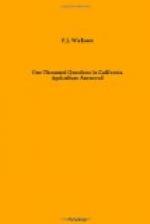Rye for Hay.
When is the best time to cut rye for hay, and how should it best be handled? Would it be well to cut it up and blow it into the barn, and would it do all right for silage?
Rye makes poor hay on account of its woody stems and must be cut earlier than other grains. After that it is handled as is other hay. Cutting it up would probably be more of a help than to other grain hay. It could be put into the silo, but would of course have to be cut pretty green and would have to run through a cutter and blower. Putting it in whole would be out of the question. In the silo, the fermentation would largely overcome the woodiness of the stems. It would also as a silage balance up nicely with alfalfa, and the best way to do would be to mix it with alfalfa when putting it in.
Rye in California.
Which kind of rye is the hardiest, the best yielding, and the best hay varieties in your State?
Rye is the least grown of all the cereals in California, and no attention has been paid to selection of varieties. That which is produced is “just rye,” of some common variety which came to the State years ago and still remains. No rye is grown for hay, as the toughness of the stem renders it undesirable for that purpose. There is a certain amount of rye grown for winter feeding. This is grown in the foothills principally and it serves an excellent purpose, but it is fed off before approaching maturity.
That Old Seven-Headed Wheat.
We are sending you some heads of grain which was grown in this county. The land was planted with an imported Australian wheat, which we believe the smaller heads to be, but the wheat is about evenly mired with grain like the large heads, which we think to be a species of barley.
The grain is an old, coarse, bearded wheat which is continually appearing in fields of ordinary grain and naturally excites interest among all to whom the variety is a novelty. It is the old seven-headed Egyptian wheat, which has never proved of any cultural value, because its manifolding of the head is of no advantage. It is better to have a straight well-filled head than to have a branching head of this kind. This matter has been fully demonstrated by experience during the last thirty or forty years, not only in this State, but in other States, for the variety has a way of getting around the world, and seed has sometimes been sold at exorbitant prices to people who have been persuaded that it is of particular value.
Speltz.
I have heard of a Russian grain called “Speltz” or “Emmer.” Can I raise it successfully and, if so, what is the very best time of year to sow some for the best crop obtainable? Can it be sown in the fall, say November? Would springtime be a better time to sow it on soil that is very soft in winter?
If your land yields good crops of wheat or barley or oats, you have little to expect from speltz or emmer. This is a grain generally considered inferior to those just mentioned and advocated for conditions under which the better known grains do not do well. It is hardy against drought and frost, particularly the latter, and is, therefore, chiefly grown in the extreme north of Europe. It may be sown in the fall or in the spring in places where rains are late and carry the plant to maturity.




